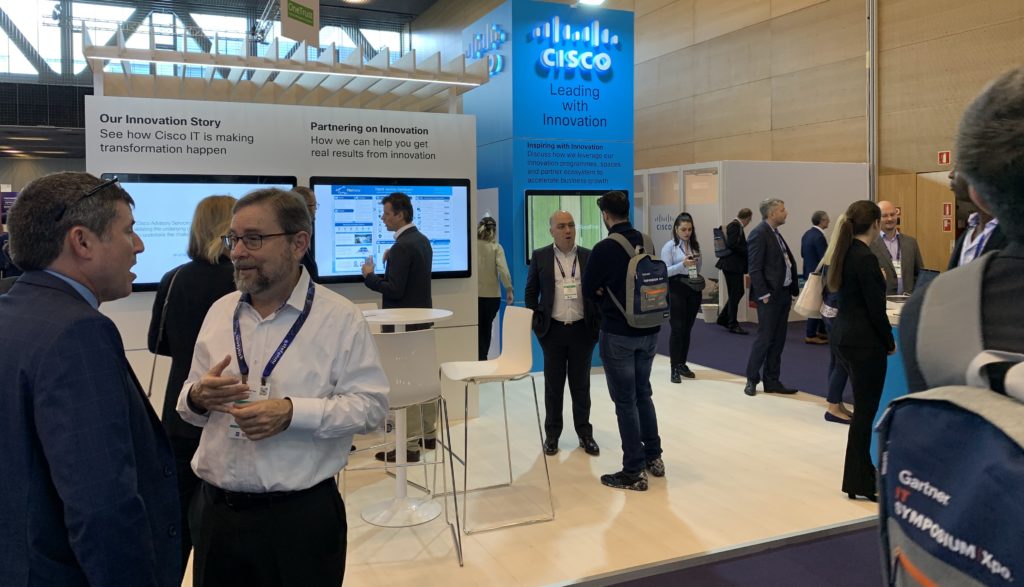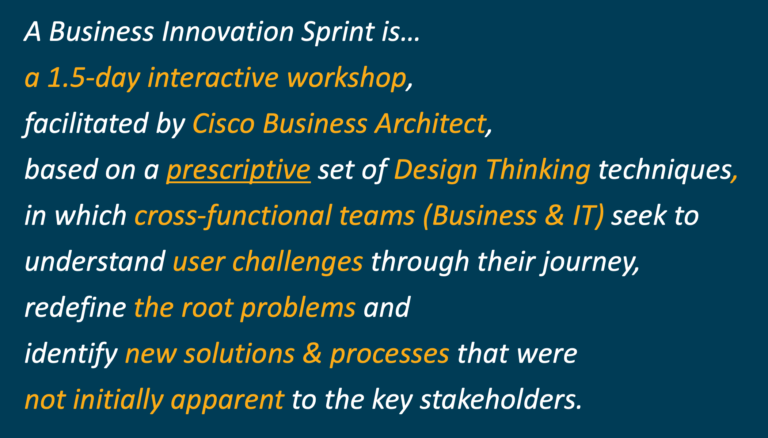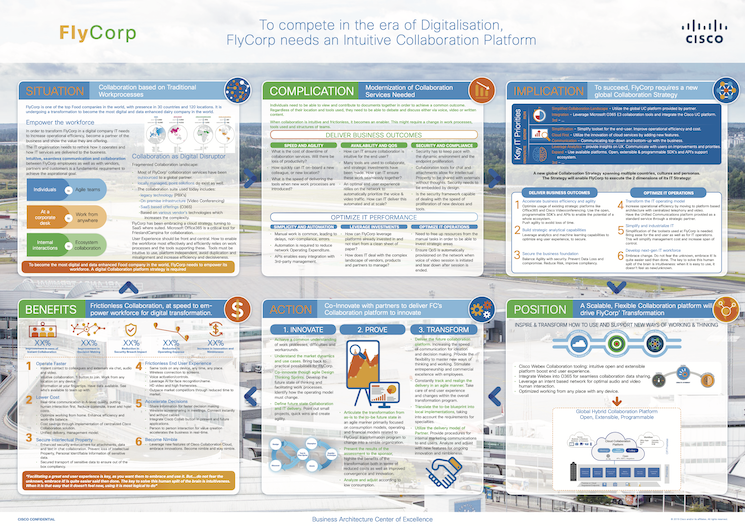Digital disruption is affecting every market sector and every industry, every organisation and every user. Yet, innovating often seems slow and complex, and changes are awkwardly interdependent. This make it difficult to communicate in a clear way ‘what’ needs to be done, and even more so to explain ‘why’ and ‘how’. Cisco’s Business Architecture Center of Excellence (BA CoE) was set up to solve exactly this problem: How can Cisco help you, our customers, deliver business impact at speed, through agile and interactive collaboration with both business & IT. Interested? Read on.
Last week at Gartner’s IT Xpo in Barcelona, the focus of Cisco’s booth (see picture below) laid squarely on innovation and how we can accelerate our customers’ business transformation. This was a timely opportunity for me to recap how Business Architects work with our customers, in close collaboration with our partners, our professional services (Customer eXperience, CX), and other innovation-focused groups within Cisco.

On the left of the booth, experts from Cisco IT shared their experiences – both positive and negative – of running Enterprise IT. They outlined to attendees how Cisco gradually transformed its internal IT operating model to focus on business innovation, improve service quality, increase employee satisfaction, and all this while lowering costs. On the right, Cisco’s Co-Innovation Centers (CIC) team showcased how Cisco works with a varied partner ecosystem to co-create new solutions answering today’s business and societal problems. Examples presented ranged from a system that connects the unconnected in rural areas, to partnerships that increase road safety, and to solutions that improve connectivity on trains.
And in the center, Cisco’s Business Architecture Center of Excellence (BA CoE) tied everything together by detailing the 6 steps we take with our customers to deliver innovation at speed:
- We create a CxO-level 1-page strategy that connects technology investments with the company’s mission, bringing together a unified digital agenda in a visual way;
- We harness vertical trends and spell out the business drivers in terms that both Business and IT understand and can act upon;
- We bridge the gap between Business & IT and gradually transform the IT department into the driver of Digital Transformation;
- We co-create innovative solutions to answer the most pressing business challenges, leveraging the power of Design Thinking and our partner ecosystem;
- Through a set of IT “Strategic Plays”, we build the multi-domain architecture that will accelerate business innovation — and we justify the Return on Investment (“IT as a Business”);
- We continuously orchestrate a healthy Customer eXperience (CX) for our customers, focused on delivering ongoing, mutual business success.
So why are we doing this again? Because driving digital transformation in today’s complex, multi-faceted environment is not evident. Powered by a community of 200 Business Architects (BAs) active throughout the globe, Cisco can help you, our customers, innovate in unique and compelling way:
- Practice over theory: for many consultants, conceiving a digital strategy becomes an objective in itself. But really, it’s only paper until the business and the users feel the benefits in their day-to-day interactions. So Cisco Business Architects avoid wasting your precious time and resources on theoretical reports – and instead, we implement real solutions, with visible and tangible impact to your key stakeholders.
- Agile and Visual: we proceed quickly and through continuous iterations. The first one is usually completed within 1 or 2 weeks. Fail fast: if you don’t like it, we rapidly change course until we get it right. Communication is key, so we facilitate collaborative workshops powered by Design Thinking and we share the business outcomes through powerful infographics.
- Share and Partner: We leverage best practices from our customers all over the world, from multiple sectors, as well as from Cisco’s own internal transformation. We openly share our lessons learned and the solutions we created. We engage our ecosystem of partners to bring you the industry expertise you need, with the impeccable execution you expect.
In this post, I’ll walk you through the 6 phases of a typical BA-led engagement, summarized in the figure below.

1. Create the big picture
Cisco Business Architects create a CxO-level, one-page strategy called “Digital Journey Dashboard” (DJD). The DJD is a large infographic that depicts the way your organisation’s strategic business drivers (the ‘why’) connect to your next-gen IT operating model (the ‘how’) and to the multi-domain architecture that will accelerate your business innovation (the ‘what’). It balances the long-term, structural transformation initiatives (the ‘marathon’) with “Business Innovation Sprints” focused on delivering tangible & visible value to the business.
The DJD helps the CIO explain and communicate the digital journey in a manner that is accessible, actionable and easy to understand by business stakeholders, but also by the people in the IT department. It connects future technology investments with the company’s mission and visualizes the unified plan that will deliver business impact at speed.

Working in close partnership with our Customer eXperience Centers (CXC), the Business Architects use the DJD to frame the overall, long-term partnership between you and Cisco: rather than pitching our products, we start from your business objectives and derive which challenges we need to focus on first. Only then do we bring into action our technology solutions, our rich partner ecosystem, and our professional services (Customer eXperience, CX).

2. Spell out the business drivers
Cisco Business Architects are skilled and tooled to harness the trends specific to your industry/market and spell out the key objectives related to your business drivers, for example:
- Customer Experience: How can we deliver an end-to-end, engaging, personalised, omni-channel experience to our customers?
- Workforce Experience: How can we evolve the day-to-day working experience of our employees, driving productivity & empowering a forward-looking culture?
- Digital First and Data Insights: How can we make better decisions, increase relevancy, availability and speed with advanced analytics and AI?
- Co-innovation and Partnerships: How can we run Joint Living Labs with trusted partners to deliver business innovation at speed?
- Risk, Security and Compliance: How can we protect and secure our assets to avoid penalties/fines/brand damage, balancing risk with innovation & value to our customers?
- Culture of Partnership & Change: How can IT improve trust and open dialog with the business to accelerate impact to market with high quality?
Using powerful Design Thinking tools and engaging with both Business & IT, we crystalize the initiatives that will realize these objectives and express them in terms that everyone understands and can act upon:

Working in close collaboration with Cisco’s Industry Solutions Group (ISG), Business Architects explore the use cases and solutions that are making a difference in your sector. Most often, these solutions require the involvement of specialized partners, able to cater for the unique challenges and opportunities in front of you. For more information, please browse through our Industry Portfolio Explorer.
3. Bridge the gap between business and IT
Cisco Business Architects understand the pivotal role played by the CIO and the IT department, repositioning IT from a mere ‘cost center’ to a leader of Digital Transformation. Nearly always, this requires a profound, ongoing evolution of the IT Operating Model, to bridge the gap between Business and IT. But you might wonder how exactly Cisco can provide credible recommendations in this area, since you would usually engage with Cisco on technology-related topics. Enter Cisco IT – yes, that’s our own internal IT department.
For a long time, Cisco has viewed IT as a critical enabler of our business strategy – in fact, we view our IT capabilities as a key competitive differentiator in our ability to deliver the best products, services and solutions to our customers. And in order to quickly adapt to changing business environments and address emerging opportunities and markets, we continuously evolve and fine-tune our IT Operating model.
Why does it matter to you? Because our experts from Cisco IT openly share our lessons learned, covering a whole span of topics, including:
- Strategy and Governance: How to be clear and transparent about what the IT department must do, who should do it, when/how, and above all, why?
- People, Culture & Communication: How to ensure that IT personnel is embracing and driving the change required by the new digital agenda?
- Architecture & IT Service Management: How to architect a service-oriented model, present all IT services through a portal, and automate their delivery to the user?
- Service Delivery & Agile Project Management: How can agile principles accelerate speed of innovation and project time-to-market?
- Sourcing and Financial Models: How to optimize IT budget and resources through modern consumption and procurement models?
- Future Skills and Roles: How to develop skills of the future so that IT can proactively meet the new business requirements?
Cisco IT can help you benchmark where your IT Department stands today in each of these areas (“AS-IS” State), define where your IT capabilities ought to be to meet and exceed the expectations of the business and users (“TO-BE” State) – and of course, help you get from AS-IS to TO-BE.
Leveraging the lessons learned from Cisco IT’s own transformation over the last decade, you can avoid the pitfalls we encountered and accelerate your transformation projects. Discover how on our “Cisco on Cisco” portal.
4. Solve business-critical challenges, using Design Thinking
In a 1.5-day collaborative workshop powered by Design Thinking techniques, Cisco Business Architects can help you harmonize the viewpoints of the business executives and IT leaders inside your organization. We call this a “Business Innovation Sprint” (BIS):

I underlined the word “prescriptive”, because it’s the secret to success of BIS. There are literally hundreds of Design Thinking tools available — and selecting which ones are right for you can be daunting. Following dozens of customer engagements, Cisco Business Architect have made this selection and developed a framework and a process proven to accelerate the speed at which our customers innovate. Effectively, we lower barrier to entry to Design Thinking by providing tested workshop agendas, trainings, tools, templates, etc.

Phrasing the Challenge Statement is a critical input to a Business Innovation Sprint. The right BIS Challenge Statement usually aligns to one of these four customer imperatives:

Here are some examples of past challenges we have worked out with customers:
- “Reimagine your applications” (with a Retail customer) – “How might we… improve our customers’ experience by combining online & offline across the journey, and increase revenue and profitability per customer?”
- “Secure your data” (with a Financial Services customer) – “How might we… remain compliant while removing friction and delays caused by security procedures?”
- “Transform your infrastructure” (with a Manufacturing customer) – “How might we… redesign the process of adding a new OT machine in our network in order to reduce provisioning time from 6 months to 1 week?”
- “Empower your teams” (with a Government customer) – “How might we… rethink the way our internal teams collaborate in order to improve employee happiness, team productivity and cross-functional collaboration?”
The Business Innovation Sprint allows us to create a Minimum Viable Product (MVP) — and because your key stakeholders were involved from the start, we are sure to address their needs and expectations. Cisco Business Architects can then engage one of Cisco’s Co-Innovation Centers (CIC) and/or our regional/global partners to bring the MVP to life, i.e. in production.
5. Build the multi-domain architecture to accelerate innovation
It’s plain and simple: silos kill innovation. Unfortunately, more often than not, technology investments are made case by case – in silo – without looking at the big picture. In order to flourish, innovation needs a platform – a secure, digital platform architected to support and accelerate your business transformation.
This is why Cisco Business Architects make sure each investment you make to fund a Business Innovation Sprint contributes to the gradual built-out of your long-term, multi-domain architecture. At the end of the day, this architecture is going to be your key competitive differentiator, whether you are a university trying to improve services to students and researchers; a bank looking to cross-sell adjacent services to existing customers; or a hospital on a mission to radically change how patients are being cared for.
Business decision makers – who hold the purse strings – find it hard to connect their strategic objectives with the technicalities of architecting this digital platform. This is why it falls upon IT to EXPLAIN and JUSTIFY.
EXPLAIN the linkage between IT’s “Strategic Plays” and the outcomes delivered to the business
Cisco Business Architects leverage the SCIPAB framework to structure and visualize the impact of IT’s “Strategic Plays” in the context of the customer’s Digital Transformation Strategy:
- Situation: Objectively, what’s the current state of the business, technology, industry, and/or mega trends?
- Complication: What are the critical issues (changes, pressures, demands, etc.) that are impacting the Situation and creating problems or opportunities?
- Implication: What are the consequences of failing to act on the problems or opportunities described in the Complication?
- Position: We then clearly and confidently state the strategic direction to solve the problems and reap the benefits.
- Action: We explain the role everyone needs to play and the key initiatives that will be undertaken in the next few weeks.
- Benefit: We describe how the recommended Position and Action will address the stakeholders’ needs, both qualitatively and quantitatively.
Over the years, Cisco Business Architects have developed dozens of SCIPAB storyboards, similar to the one below.

JUSTIFY the investment through a financial analysis and ROI model
IT as a Business, or ITaaB, is a structured engagement process and tooling which enable Cisco Business Architects to develop a financial value proposition and demonstrate to your business stakeholders the Capability, Cost, Compliance and Calendar (speed) benefits of evolving towards a multi-domain architecture. Typical areas of focus include: Secure Access, Secure SD-WAN, and Secure DC Network.

6. Create a virtuous lifecycle for ongoing success
Today’s IT projects are more complex and interdependent than ever, spanning multiple technology domains and affecting a myriad of stakeholders. Environments and requirements change every day. In-house IT teams are always short on resources and critical skills.
In this context, success relies on the effective orchestration of all involved parties throughout the business transformation lifecycle.

Cisco Business Architects are the orchestrators. The tools that we have developed over many years (e.g. Digital Journey Dashboard, Business Innovation Sprints, SCIPAB, ITaaB LITE) empower us to build bridges and establish an open collaboration and clear communication between our customers, our rich partner ecosystem, our professional services (Customer eXperience, CX), as well as engaging the many parties within Cisco focused on customer innovation, including Cisco IT, Industry Solutions Group, Co-Innovation Centers, Customer eXperience (CX), Partner Organisation, etc.
We bring our expertise to all kinds of projects, all founded on a simple ethos: to deliver business impact at speed.
If you are interested in engaging with Cisco to accelerate your innovation and increase the business impact of technology investments, please contact your local Cisco account team and ask for the support of a Business Architect.

Hello Patrick –
I have been following your Blogs for a while now, You are been very articulate in describing key concepts. Thank you for sharing your thoughts and wisdom, truly appreciate it !
I have tried to translate the 6 Phases of a Typical Business Architecture-Led Engagement to Deliver Business Impact at Speed which you recently shared, with the earlier 3 Phase Strategic IT Roadmap (SITR) or Strategic Roadmap to Fast IT
Please let me know if the below translation is correct , else please correct the same and fill in the blanks.
• Phase 1 of Strategic IT Framework (SITR) aka Strategic Roadmap to Fast IT – Business Drivers from Cobit 5 Framework and BSC aka Digital Journey Dashboard
(DJD)
• Phase 2 of Strategic IT Framework (SITR) aka Strategic Roadmap to Fast IT – IT Value Map aka Business Innovation Sprint using Design Thinking
• Phase 3 of Strategic IT Framework (SITR) aka Strategic Roadmap to Fast IT – Detailed Roadmap of Programs and Projects aka SCIPAB Story Board Framework
Also, is Business Architect aka Solutions Architect as you have used both terms in previous blogs.
Thanks,
Hello Badrish,
Many thanks for your thoughtful analysis and questions.
Yes, the mapping you have done is totally accurate. SITR has evolved over the last 5 years into the full practice of Cisco Business Architecture, but the foundation remains the same:
1) Build the big picture with a 1-page strategy = Digital Journey Dashboard (DJD)
2) Focus innovation on strategic business challenges = Business Innovation Sprints (BIS)
3) Gradually build the technology platform, architected to have all components working together = SCIPAB Storyboard to explain how each Strategic IT Plays support key business drivers.
Naturally, while the foundation remains the same, Cisco BA has immensely matured, following the dozens of customer engagements we have led over the years.
“Business Architect” is indeed used in a similar fashion as “Business Solutions Architect”. Within Cisco, BSA is used as a actual job title, whereas BA is a skill/capability that any Systems Engineer should develop, at various stages of expertise.
Hello Patrick –
Thanks for your clear concise response!
Cheers,